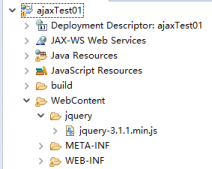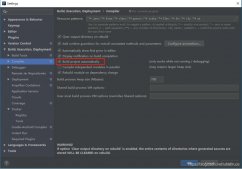ByteArrayInputStream 介绍
ByteArrayInputStream 是字节数组输入流。它继承于InputStream。
它包含一个内部缓冲区,该缓冲区包含从流中读取的字节;通俗点说,它的内部缓冲区就是一个字节数组,而ByteArrayInputStream本质就是通过字节数组来实现的。
我们都知道,InputStream通过read()向外提供接口,供它们来读取字节数据;而ByteArrayInputStream 的内部额外的定义了一个计数器,它被用来跟踪 read() 方法要读取的下一个字节。
InputStream 函数列表
|
1
2
3
4
5
6
7
8
9
10
11
12
|
// 构造函数InputStream() int available() void close() void mark(int readlimit) boolean markSupported() int read(byte[] buffer)abstract int read() int read(byte[] buffer, int offset, int length)synchronized void reset() long skip(long byteCount) |
ByteArrayInputStream 函数列表
|
1
2
3
4
5
6
7
8
9
10
11
|
// 构造函数ByteArrayInputStream(byte[] buf)ByteArrayInputStream(byte[] buf, int offset, int length)synchronized int available() void close()synchronized void mark(int readlimit) boolean markSupported()synchronized int read()synchronized int read(byte[] buffer, int offset, int length)synchronized void reset()synchronized long skip(long byteCount) |
InputStream和ByteArrayInputStream源码分析
InputStream是ByteArrayInputStream的父类,我们先看看InputStream的源码,然后再学ByteArrayInputStream的源码。
1. InputStream.java源码分析(基于jdk1.7.40)
|
1
2
3
4
5
6
7
8
9
10
11
12
13
14
15
16
17
18
19
20
21
22
23
24
25
26
27
28
29
30
31
32
33
34
35
36
37
38
39
40
41
42
43
44
45
46
47
48
49
50
51
52
53
54
55
56
57
58
59
60
61
62
63
64
65
66
67
|
package java.io; public abstract class InputStream implements Closeable { // 能skip的大小 private static final int MAX_SKIP_BUFFER_SIZE = ; // 从输入流中读取数据的下一个字节。 public abstract int read() throws IOException; // 将数据从输入流读入 byte 数组。 public int read(byte b[]) throws IOException { return read(b, 0, b.length); } // 将最多 len 个数据字节从此输入流读入 byte 数组。 public int read(byte b[], int off, int len) throws IOException { if (b == null) { throw new NullPointerException(); } else if (off < 0 || len < 0 || len > b.length - off) { throw new IndexOutOfBoundsException(); } else if (len == 0) { return 0; } int c = read(); if (c == -1) { return -1; } b[off] = (byte)c; int i = 1; try { for (; i < len ; i++) { c = read(); if (c == -) { break; } b[off + i] = (byte)c; } } catch (IOException ee) { } return i; } // 跳过输入流中的n个字节 public long skip(long n) throws IOException { long remaining = n; int nr; if (n <= 0) { return 0; } int size = (int)Math.min(MAX_SKIP_BUFFER_SIZE, remaining); byte[] skipBuffer = new byte[size]; while (remaining > 0) { nr = read(skipBuffer, 0, (int)Math.min(size, remaining)); if (nr < 0) { break; } remaining -= nr; } return n - remaining; } public int available() throws IOException { return 0; } public void close() throws IOException {} public synchronized void mark(int readlimit) {} public synchronized void reset() throws IOException { throw new IOException("mark/reset not supported"); } public boolean markSupported() { return false; } } |
2. ByteArrayInputStream.java源码分析(基于jdk1.7.40)
|
1
2
3
4
5
6
7
8
9
10
11
12
13
14
15
16
17
18
19
20
21
22
23
24
25
26
27
28
29
30
31
32
33
34
35
36
37
38
39
40
41
42
43
44
45
46
47
48
49
50
51
52
53
54
55
56
57
58
59
60
61
62
63
64
65
66
67
68
69
70
71
72
73
74
75
76
77
78
79
80
81
82
83
84
85
|
package java.io; public class ByteArrayInputStream extends InputStream { // 保存字节输入流数据的字节数组 protected byte buf[]; // 下一个会被读取的字节的索引 protected int pos; // 标记的索引 protected int mark = 0; // 字节流的长度 protected int count; // 构造函数:创建一个内容为buf的字节流 public ByteArrayInputStream(byte buf[]) { // 初始化“字节流对应的字节数组为buf” this.buf = buf; // 初始化“下一个要被读取的字节索引号为” this.pos = ; // 初始化“字节流的长度为buf的长度” this.count = buf.length; } // 构造函数:创建一个内容为buf的字节流,并且是从offset开始读取数据,读取的长度为length public ByteArrayInputStream(byte buf[], int offset, int length) { // 初始化“字节流对应的字节数组为buf” this.buf = buf; // 初始化“下一个要被读取的字节索引号为offset” this.pos = offset; // 初始化“字节流的长度” this.count = Math.min(offset + length, buf.length); // 初始化“标记的字节流读取位置” this.mark = offset; } // 读取下一个字节 public synchronized int read() { return (pos < count) ? (buf[pos++] & 0xff) : -1; } // 将“字节流的数据写入到字节数组b中” // off是“字节数组b的偏移地址”,表示从数组b的off开始写入数据 // len是“写入的字节长度” public synchronized int read(byte b[], int off, int len) { if (b == null) { throw new NullPointerException(); } else if (off < 0 || len < 0 || len > b.length - off) { throw new IndexOutOfBoundsException(); } if (pos >= count) { return -1; } int avail = count - pos; if (len > avail) { len = avail; } if (len <= 0) { return 0; } System.arraycopy(buf, pos, b, off, len); pos += len; return len; } // 跳过“字节流”中的n个字节。 public synchronized long skip(long n) { long k = count - pos; if (n < k) { k = n < 0 ? 0 : n; } pos += k; return k; } // “能否读取字节流的下一个字节” public synchronized int available() { return count - pos; } // 是否支持“标签” public boolean markSupported() { return true; } // 保存当前位置。readAheadLimit在此处没有任何实际意义 public void mark(int readAheadLimit) { mark = pos; } // 重置“字节流的读取索引”为“mark所标记的位置” public synchronized void reset() { pos = mark; } public void close() throws IOException { } } |
说明:
ByteArrayInputStream实际上是通过“字节数组”去保存数据。
(01) 通过ByteArrayInputStream(byte buf[]) 或 ByteArrayInputStream(byte buf[], int offset, int length) ,我们可以根据buf数组来创建字节流对象。
(02) read()的作用是从字节流中“读取下一个字节”。
(03) read(byte[] buffer, int offset, int length)的作用是从字节流读取字节数据,并写入到字节数组buffer中。offset是将字节写入到buffer的起始位置,length是写入的字节的长度。
(04) markSupported()是判断字节流是否支持“标记功能”。它一直返回true。
(05) mark(int readlimit)的作用是记录标记位置。记录标记位置之后,某一时刻调用reset()则将“字节流下一个被读取的位置”重置到“mark(int readlimit)所标记的位置”;也就是说,reset()之后再读取字节流时,是从mark(int readlimit)所标记的位置开始读取。
示例代码
关于ByteArrayInputStream中API的详细用法,参考示例代码(ByteArrayInputStreamTest.java):
|
1
2
3
4
5
6
7
8
9
10
11
12
13
14
15
16
17
18
19
20
21
22
23
24
25
26
27
28
29
30
31
32
33
34
35
36
37
38
39
40
41
42
43
44
45
46
47
48
49
50
51
52
53
54
55
56
57
58
59
|
import java.io.ByteArrayInputStream;import java.io.ByteArrayOutputStream;/** * ByteArrayInputStream 测试程序 * */public class ByteArrayInputStreamTest { private static final int LEN = 5; // 对应英文字母“abcddefghijklmnopqrsttuvwxyz” private static final byte[] ArrayLetters = { 0x61, 0x62, 0x63, 0x64, 0x65, 0x66, 0x67, 0x68, 0x69, 0x6A, 0x6B, 0x6C, 0x6D, 0x6E, 0x6F, 0x70, 0x71, 0x72, 0x73, 0x74, 0x75, 0x76, 0x77, 0x78, 0x79, 0x7A }; public static void main(String[] args) { String tmp = new String(ArrayLetters); System.out.println("ArrayLetters="+tmp); tesByteArrayInputStream() ; } /** * ByteArrayInputStream的API测试函数 */ private static void tesByteArrayInputStream() { // 创建ByteArrayInputStream字节流,内容是ArrayLetters数组 ByteArrayInputStream bais = new ByteArrayInputStream(ArrayLetters); // 从字节流中读取5个字节 for (int i=0; i<LEN; i++) { // 若能继续读取下一个字节,则读取下一个字节 if (bais.available() >= 0) { // 读取“字节流的下一个字节” int tmp = bais.read(); System.out.printf("%d : 0x%s\n", i, Integer.toHexString(tmp)); } } // 若“该字节流”不支持标记功能,则直接退出 if (!bais.markSupported()) { System.out.println("make not supported!"); return ; } // 标记“字节流中下一个被读取的位置”。即--标记“0x66”,因为因为前面已经读取了5个字节,所以下一个被读取的位置是第6个字节” // (01), ByteArrayInputStream类的mark(0)函数中的“参数0”是没有实际意义的。 // (02), mark()与reset()是配套的,reset()会将“字节流中下一个被读取的位置”重置为“mark()中所保存的位置” bais.mark(0); // 跳过5个字节。跳过5个字节后,字节流中下一个被读取的值应该是“0x6B”。 bais.skip(5); // 从字节流中读取5个数据。即读取“0x6B, 0x6C, 0x6D, 0x6E, 0x6F” byte[] buf = new byte[LEN]; bais.read(buf, 0, LEN); // 将buf转换为String字符串。“0x6B, 0x6C, 0x6D, 0x6E, 0x6F”对应字符是“klmno” String str1 = new String(buf); System.out.printf("str1=%s\n", str1); // 重置“字节流”:即,将“字节流中下一个被读取的位置”重置到“mark()所标记的位置”,即0x66。 bais.reset(); // 从“重置后的字节流”中读取5个字节到buf中。即读取“0x66, 0x67, 0x68, 0x69, 0x6A” bais.read(buf, 0, LEN); // 将buf转换为String字符串。“0x66, 0x67, 0x68, 0x69, 0x6A”对应字符是“fghij” String str2 = new String(buf); System.out.printf("str2=%s\n", str2); }} |
运行结果:
|
1
2
3
4
5
6
7
8
|
ArrayLetters=abcdefghijklmnopqrstuvwxyz0 : 0x611 : 0x622 : 0x633 : 0x644 : 0x65str1=klmnostr2=fghij |
结果说明:
(01) ArrayLetters 是字节数组。0x61对应的ASCII码值是a,0x62对应的ASCII码值是b,依次类推...
(02) ByteArrayInputStream bais = new ByteArrayInputStream(ArrayLetters); 这句话是创建“字节流bais”,它的内容就是ArrayLetters。
(03) for (int i=0; i<LEN; i++) ; 这个for循环的作用就是从字节流中读取5个字节。每次调用bais.read()就从字节流中读取一个字节。
(04) bais.mark(0); 这句话就是“设置字节流的标记”,此时标记的位置对应的值是0x66。
(05) bais.skip(5); 这句话是跳过5个字节。跳过5个字节后,对应的字节流中下一个被读取的字节的值是0x6B。
(06) bais.read(buf, 0, LEN); 这句话是“从字节流中读取LEN个数据写入到buf中,0表示从buf的第0个位置开始写入”。
(07) bais.reset(); 这句话是将“字节流中下一个被读取的位置”重置到“mark()所标记的位置”,即0x66。
学完了ByteArrayInputStream输入流。下面,我们学习与之对应的输出流ByteArrayOutputStream。
以上所述是小编给大家介绍的ByteArrayInputStream简介和使用,希望对大家有所帮助,如果大家有任何疑问请给我留言,小编会及时回复大家的。在此也非常感谢大家对服务器之家网站的支持!













